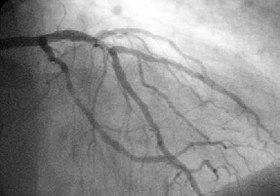Coronary angioplasty
| Percutaneous coronary intervention | |
|---|---|
| Intervention | |

A coronary angiogram showing the circulation in the left main coronary artery and its branches.
|
|
| Synonyms | Percutaneous transluminal coronary angioplasty (PTCA), coronary angioplasty |
| ICD-9-CM | 36.09, 00.66 |
Percutaneous coronary intervention (PCI) is a non-surgical procedure used to treat narrowing (stenosis) of the coronary arteries of the heart found in coronary artery disease. After accessing the blood stream through the femoral or radial artery, the procedure uses coronary catheterization to visualise the blood vessels on X-ray imaging. After this, an interventional cardiologist can perform a coronary angioplasty, using a balloon catheter in which a deflated balloon is advanced into the obstructed artery and inflated to relieve the narrowing; certain devices such as stents can be deployed to keep the blood vessel open. Various other procedures can also be performed.
Primary PCI is the very urgent use of PCI in people with acute myocardial infarction (heart attack), especially where there is evidence of severe heart damage on the electrocardiogram (ST elevation MI). PCI is also used in people after other forms of myocardial infarction or unstable angina where there is a high risk of further events. Finallly, PCI may be used in people with stable angina pectoris, particularly if the symptoms are difficult to control with medication. PCI is an alternative to coronary artery bypass grafting (CABG, bypass surgery), which bypasses stenotic arteries by grafting vessels from elsewhere in the body. Under certain circumstances (extensive blockages, background of diabetes), CABG may be superior.
Coronary angioplasty was first introduced in 1977 by Andreas Gruentzig in Switzerland.
...
Wikipedia
